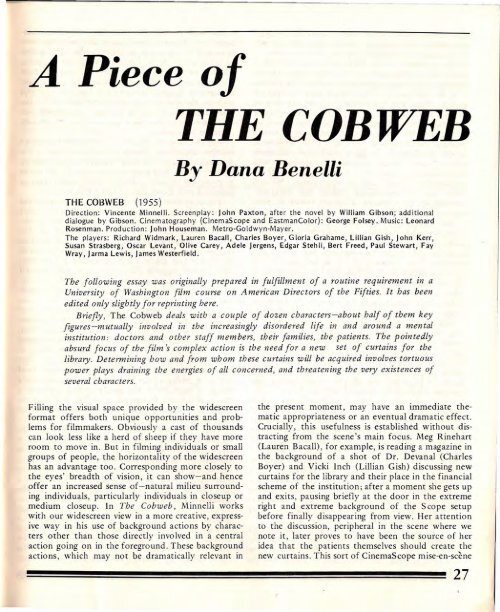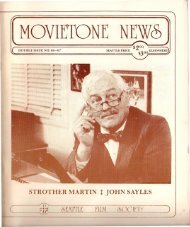MOVIETONE NEW8 . - Parallax View Annex
MOVIETONE NEW8 . - Parallax View Annex
MOVIETONE NEW8 . - Parallax View Annex
You also want an ePaper? Increase the reach of your titles
YUMPU automatically turns print PDFs into web optimized ePapers that Google loves.
A Piece of<br />
THE COBWEB<br />
By Dana Benelli<br />
THE COBWEB (1955)<br />
Direction: Vincente Minnelli. Screenplay: john Paxton, after the novel by William Gibson; additional<br />
dialogue by Gibson. Cinematography (CinemaScope and EastmanColor): George Folsey. Music: Leonard<br />
Rosenman. Production: john Houseman. Metro-Goldwyn-Mayer.<br />
The players: Richard Widmark, Lauren Bacall, Charles Boyer, Gloria Grahame, Lillian Gish, john Kerr,<br />
Susan Strasberg , Oscar Levant, Olive Carey, Adele Jergens, Edgar Steh li, Bert Freed, Paul Stewart, Fay<br />
Wray, jarma Lewis, James Westerfield. .<br />
The following essay was originally prepared in fulfillment of a routine requirement in a<br />
University of Washington film course on American Directors of the Fifties. It has been<br />
edited only slightly for reprinting here.<br />
Briefly, The Cobweb deals with a couple of dozen characters-about half of them key<br />
figures-mutually involved in the increasingly disordered life in and around a mental<br />
institution: doctors and other staff members, their families, the patients. The pointedly<br />
absurd focus of the film's complex action is the need for a new set of curtains for the<br />
library. Determining how and from whom these curtains will be acquired involves tortuous<br />
power plays draining the energies of all concerned, and threatening the very existences of<br />
several characters.<br />
Filling the visual space provided by the widescreen<br />
format offers both unique opportunities and problems<br />
for filmmakers. Obviously a cast of thousands<br />
can look less like a herd of sheep if they have more<br />
room to move in. But in filming individuals or small<br />
groups of people, the horizontality of the widescreen<br />
has an advantage too. Corresponding more closely to<br />
the eyes' breadth of vision, it can show-and hence<br />
offer an increased sense of-natural milieu surrounding<br />
individuals, particularly individuals in closeup or<br />
medium closeup. In The Cobweb, Minnelli works<br />
with our widescreen view in a more creative, expressive<br />
way in his use of background actions by characters<br />
other than those directly involved in a central<br />
action going on in the foreground. These background<br />
actions, which may not be dramatically relevant in<br />
the present moment, may have an immediate thematic<br />
appropriateness or an eventual dramatic effect.<br />
Crucially, this usefulness is established without distracting<br />
from the scene's main focus. Meg Rinehart<br />
(Lauren Bacall), for example, is reading a magazine in<br />
the background of a shot of Dr. Devanal (Charles<br />
Boyer) and Vicki Inch (Lillian Gish) discussing new<br />
curtains for the library and their place in the financial<br />
scheme of the institution; after a moment she gets up<br />
and exits, pausing briefly at the door in the extreme<br />
right and extreme background of the Scope setup<br />
before finally disappearing from view. Her attention<br />
to the discussion, peripheral in the scene where we<br />
note it, later proves to have been the source of her<br />
idea that the patients themselves should create the<br />
new curtains. This sort of CinemaS cope mise-en-scene<br />
27




